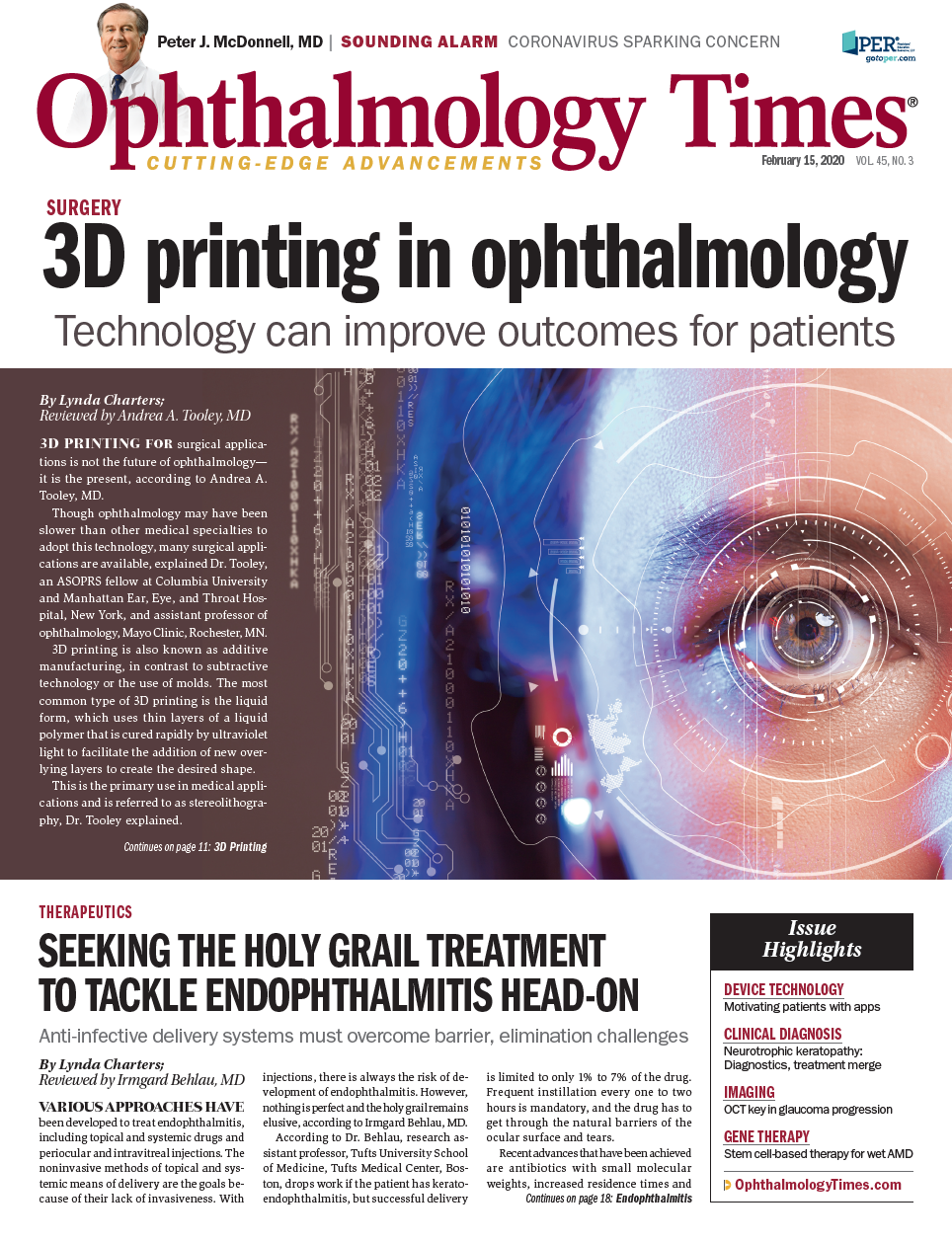Publication
Article
Digital Edition
3D printing in ophthalmology
Author(s):

This article was reviewed by Andrea A. Tooley, MD
According to Andrea A. Tooley, MD, 3D printing for surgical applications is not the future of ophthalmology. It is the present.
While ophthalmology has been slower than other medical specialties to adopt the surgical applications of this technology, many applications are available, noted Dr. Tooley, an ASOPRS fellow at Columbia University and Manhattan Ear, Eye, and Throat Hospital, New York, and assistant professor of ophthalmology, Mayo Clinic, Rochester, MN.
3D printing is also known as additive manufacturing, in contrast to subtractive technology or the use of molds. The most common type of 3D printing is the liquid form, which uses thin layers of a liquid polymer that is cured rapidly by ultraviolet light to facilitate the addition of new overlying layers to create the desired shape. This is the primary use in medical applications and is referred to as stereolithography, Dr. Tooley explained.
Cardiovascular surgery, neurosurgery, orthopedics, and audiology are some of the medical areas that are taking advantage of the technology. However, she emphasized, 3D printing has a huge application in reconstructive surgeries as well as face transplantations.
Within ophthalmology, Dr. Tooley believes that the future may lie in 3D printed corneas, conjunctiva, surgical tools, and glaucoma drainage devices. Science fiction is becoming science fact.
Researchers at Newcastle University, Tyne, U.K., have 3D-printed corneas. For every person in the world who receives a cornea transplant, there are 69 others who still need one. As a result, more than 12 million people worldwide have limited sight due to a lack of eye donors.
The research, led by Che Connon, PhD, and Steven Swioklo, PhD, developed the first 3D-printed cornea made with human cells.
3D printing in surgery surgical models may be used outside of the operating room and are instrumental in surgical planning.
Dr. Tooley noted that in complex cardiac cases, the exact patient anatomy can be 3D printed and then can be used for practice before the actual surgery. Neurosurgeons can use the technology to prepare for complex aneurysmal repairs. She recounted that some cardiac surgeons are 3D printing their patients’ hearts and placing them inside a mannequin chest to establish the precise ergonomics they will encounter during the actual surgery.
“I believe that this has great potential for education in Ophthalmology,” she said.
Dr. Tooley demonstrated a model of a 3D-printed orbit that she is currently using for a magnetic resonance imaging study of orbital tumors being performed at Columbia University, New York. Many universities, Columbia included, are now providing 3D printing free of charge for physicians.
Another application for the technology is the creation of surgical instruments. This approach could cut the costs of creating a prototype by an instrument manufacturer. Surgeons can then use the 3D printed instruments for practice in the laboratory and the instrument can be redesigned as needed.
surgical guides can be printed and used in the operating room.
“Many studies have shown that surgical guides that are 3D printed not only decrease the time spent in the operating room, but they also improve surgical accuracy,” Dr. Tooley pointed out.
Dr. Tooley also noted that 3D printing of surgical guides is especially important for orbital surgeries and craniofacial reconstruction.
“The scans of our patients can be custom used to create a 3D model of their anatomy or of the defect to be repaired and that model can be used in the operating room,” she said, describing a model used in a patient with a large orbital medial wall and floor defect resulting from removal of a tumor.
“We were able to have a specific 3D printed guide that exactly matched the defect,” she said. “The titanium implant then could be shaped and modeled according to the 3D printed model, which reduces the time in surgery.”
Finally, customized patient implants are another possibility that can remain inside the patient.
These custom implants are used when transplanting a face from the donor to the recipient. Because this surgery demands absolute precision, cutting guides are printed and placed on the donor to indicate exactly where the cuts are to be made in the bone or tissue. This facilitates a perfect fit on the recipient.
An example of another application was seen in the case of a patient with hemifacial microsomia. The surgeons were able to 3D print a custom implant that matched the normal side of the patient’s face.
“It fit her anatomy and was symmetrical with the other side of her face,” Dr. Tooley reported.
The 3D printed materials also can be used in anophthalmic sockets. The printed implants perfectly match the defects in volume and anatomic requirements.
Dr. Tooley concluded that some of the most exciting factors in 3D printing is bioprinting in which live cells are printed onto a live matrix.
“This enables the building of an actual structure, such as ears or parts of the skull. That then can be implanted into patients,” she said. “In ophthalmology, the future is 3D printing of corneas or extra needed tissue. Even more imminent are customized 3D printed glaucoma valves or intraocular lenses. This is a tremendous technology that is at our fingertips.”
Andrea A. Tooley, MD
E: tooley.andrea@mayo.edu
This article is based on Dr. Tooley's presentation at the American Academy of Ophthalmology 2019 annual meeting. Dr. Tooley has no financial interest in any aspect of this report.
Newsletter
Don’t miss out—get Ophthalmology Times updates on the latest clinical advancements and expert interviews, straight to your inbox.






